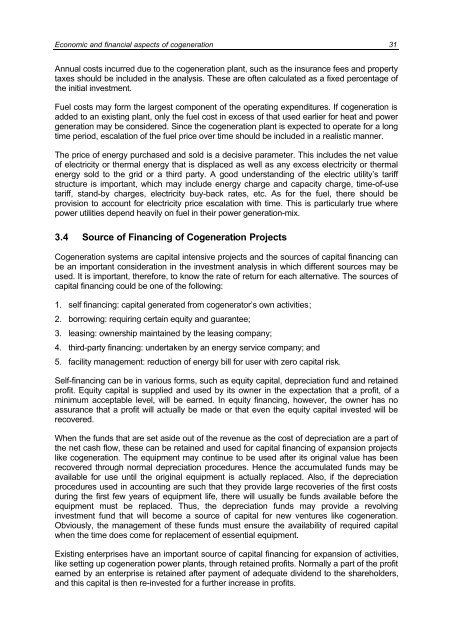part 1: overview of cogeneration and its status in asia - Fire
part 1: overview of cogeneration and its status in asia - Fire
part 1: overview of cogeneration and its status in asia - Fire
You also want an ePaper? Increase the reach of your titles
YUMPU automatically turns print PDFs into web optimized ePapers that Google loves.
Economic <strong>and</strong> f<strong>in</strong>ancial aspects <strong>of</strong> <strong>cogeneration</strong> 31<br />
Annual costs <strong>in</strong>curred due to the <strong>cogeneration</strong> plant, such as the <strong>in</strong>surance fees <strong>and</strong> property<br />
taxes should be <strong>in</strong>cluded <strong>in</strong> the analysis. These are <strong>of</strong>ten calculated as a fixed percentage <strong>of</strong><br />
the <strong>in</strong>itial <strong>in</strong>vestment.<br />
Fuel costs may form the largest component <strong>of</strong> the operat<strong>in</strong>g expenditures. If <strong>cogeneration</strong> is<br />
added to an exist<strong>in</strong>g plant, only the fuel cost <strong>in</strong> excess <strong>of</strong> that used earlier for heat <strong>and</strong> power<br />
generation may be considered. S<strong>in</strong>ce the <strong>cogeneration</strong> plant is expected to operate for a long<br />
time period, escalation <strong>of</strong> the fuel price over time should be <strong>in</strong>cluded <strong>in</strong> a realistic manner.<br />
The price <strong>of</strong> energy purchased <strong>and</strong> sold is a decisive parameter. This <strong>in</strong>cludes the net value<br />
<strong>of</strong> electricity or thermal energy that is displaced as well as any excess electricity or thermal<br />
energy sold to the grid or a third <strong>part</strong>y. A good underst<strong>and</strong><strong>in</strong>g <strong>of</strong> the electric utility’s tariff<br />
structure is important, which may <strong>in</strong>clude energy charge <strong>and</strong> capacity charge, time-<strong>of</strong>-use<br />
tariff, st<strong>and</strong>-by charges, electricity buy-back rates, etc. As for the fuel, there should be<br />
provision to account for electricity price escalation with time. This is <strong>part</strong>icularly true where<br />
power utilities depend heavily on fuel <strong>in</strong> their power generation-mix.<br />
3.4 Source <strong>of</strong> F<strong>in</strong>anc<strong>in</strong>g <strong>of</strong> Cogeneration Projects<br />
Cogeneration systems are capital <strong>in</strong>tensive projects <strong>and</strong> the sources <strong>of</strong> capital f<strong>in</strong>anc<strong>in</strong>g can<br />
be an important consideration <strong>in</strong> the <strong>in</strong>vestment analysis <strong>in</strong> which different sources may be<br />
used. It is important, therefore, to know the rate <strong>of</strong> return for each alternative. The sources <strong>of</strong><br />
capital f<strong>in</strong>anc<strong>in</strong>g could be one <strong>of</strong> the follow<strong>in</strong>g:<br />
1. self f<strong>in</strong>anc<strong>in</strong>g: capital generated from cogenerator’s own activities;<br />
2. borrow<strong>in</strong>g: requir<strong>in</strong>g certa<strong>in</strong> equity <strong>and</strong> guarantee;<br />
3. leas<strong>in</strong>g: ownership ma<strong>in</strong>ta<strong>in</strong>ed by the leas<strong>in</strong>g company;<br />
4. third-<strong>part</strong>y f<strong>in</strong>anc<strong>in</strong>g: undertaken by an energy service company; <strong>and</strong><br />
5. facility management: reduction <strong>of</strong> energy bill for user with zero capital risk.<br />
Self-f<strong>in</strong>anc<strong>in</strong>g can be <strong>in</strong> various forms, such as equity capital, depreciation fund <strong>and</strong> reta<strong>in</strong>ed<br />
pr<strong>of</strong>it. Equity capital is supplied <strong>and</strong> used by <strong>its</strong> owner <strong>in</strong> the expectation that a pr<strong>of</strong>it, <strong>of</strong> a<br />
m<strong>in</strong>imum acceptable level, will be earned. In equity f<strong>in</strong>anc<strong>in</strong>g, however, the owner has no<br />
assurance that a pr<strong>of</strong>it will actually be made or that even the equity capital <strong>in</strong>vested will be<br />
recovered.<br />
When the funds that are set aside out <strong>of</strong> the revenue as the cost <strong>of</strong> depreciation are a <strong>part</strong> <strong>of</strong><br />
the net cash flow, these can be reta<strong>in</strong>ed <strong>and</strong> used for capital f<strong>in</strong>anc<strong>in</strong>g <strong>of</strong> expansion projects<br />
like <strong>cogeneration</strong>. The equipment may cont<strong>in</strong>ue to be used after <strong>its</strong> orig<strong>in</strong>al value has been<br />
recovered through normal depreciation procedures. Hence the accumulated funds may be<br />
available for use until the orig<strong>in</strong>al equipment is actually replaced. Also, if the depreciation<br />
procedures used <strong>in</strong> account<strong>in</strong>g are such that they provide large recoveries <strong>of</strong> the first costs<br />
dur<strong>in</strong>g the first few years <strong>of</strong> equipment life, there will usually be funds available before the<br />
equipment must be replaced. Thus, the depreciation funds may provide a revolv<strong>in</strong>g<br />
<strong>in</strong>vestment fund that will become a source <strong>of</strong> capital for new ventures like <strong>cogeneration</strong>.<br />
Obviously, the management <strong>of</strong> these funds must ensure the availability <strong>of</strong> required capital<br />
when the time does come for replacement <strong>of</strong> essential equipment.<br />
Exist<strong>in</strong>g enterprises have an important source <strong>of</strong> capital f<strong>in</strong>anc<strong>in</strong>g for expansion <strong>of</strong> activities,<br />
like sett<strong>in</strong>g up <strong>cogeneration</strong> power plants, through reta<strong>in</strong>ed pr<strong>of</strong><strong>its</strong>. Normally a <strong>part</strong> <strong>of</strong> the pr<strong>of</strong>it<br />
earned by an enterprise is reta<strong>in</strong>ed after payment <strong>of</strong> adequate dividend to the shareholders,<br />
<strong>and</strong> this capital is then re-<strong>in</strong>vested for a further <strong>in</strong>crease <strong>in</strong> pr<strong>of</strong><strong>its</strong>.









